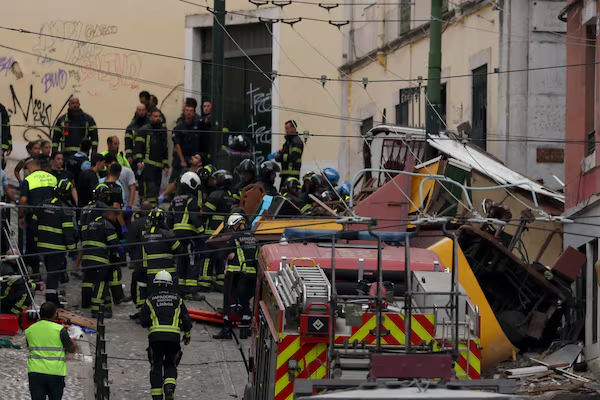The streets of Lisbon, known for their charm, history, and iconic streetcars, turned into a scene of devastation after a tragic derailment shook the city. A popular funicular carrying dozens of passengers came off its tracks, leading to a catastrophic accident that has already claimed at least 15 lives and left many others injured. The crash has cast a shadow over one of Europe’s most beloved tourist cities, sparking grief, outrage, and urgent calls for answers about how such a disaster could happen in the heart of Portugal’s capital.
- The Fateful Day of the Lisbon Streetcar Crash
- Historical Significance of Lisbon’s Funiculars
- Eyewitness Accounts Paint a Grim Picture
- Rescue Operations and Emergency Response
- Investigating the Cause of the Crash
- Global Reactions and Tourism Concerns
- Expert Opinions on Transport Safety
- Lisbon’s Mourning and Public Outcry
- What Comes Next for Lisbon’s Funiculars
- FAQs
- What caused the Lisbon streetcar crash?
- How many people died in the Lisbon funicular derailment?
- Were tourists among the victims?
- Are Lisbon’s funiculars generally safe?
- Will Lisbon shut down other funiculars after the crash?
- Conclusion
The incident has triggered both national and international concern, not only because of the high death toll but also because of what it represents for public safety in one of the busiest and most tourist-dependent cities in Europe. With officials scrambling to investigate, eyewitnesses recounting harrowing details, and families mourning their loved ones, the Lisbon streetcar tragedy has quickly become one of the most shocking transport disasters in recent European history.
The Fateful Day of the Lisbon Streetcar Crash
It was an ordinary day in Lisbon, bustling with tourists and locals enjoying the late summer atmosphere. Streetcars and funiculars, the city’s hallmark mode of transport, were operating as usual, carrying passengers across the steep, winding streets. But what was supposed to be a routine ride on a historic funicular turned into an unspeakable nightmare when the vehicle suddenly derailed while descending one of Lisbon’s steepest tracks.
Witnesses reported hearing a loud metallic screech before the funicular lost control, plummeting sideways and crashing violently into a retaining wall. The sudden derailment flung passengers against the car’s interior, while others were ejected from the vehicle entirely. Rescue teams rushed to the scene within minutes, but the scale of destruction was already apparent.
Local media confirmed that at least 15 people lost their lives, while dozens more sustained injuries ranging from broken bones to severe head trauma. The street, once filled with tourists snapping photos of Lisbon’s picturesque transport system, became littered with twisted metal, shattered glass, and desperate cries for help.
Historical Significance of Lisbon’s Funiculars
Lisbon’s funiculars are not just transport systems; they are icons of the city itself. First introduced in the late 19th century, they have become symbols of Lisbon’s identity, frequently appearing in travel brochures, films, and cultural depictions of the Portuguese capital. Tourists flock to ride them, not merely for convenience but for the experience of ascending and descending Lisbon’s famous hills in vintage vehicles that combine nostalgia with utility.
The most popular funiculars, such as Elevador da Glória and Elevador da Bica, have long been regarded as safe, charming, and essential to Lisbon’s tourism economy. To many, these rides are as central to Lisbon’s cultural DNA as Fado music or pastel de nata pastries. This tragic accident, therefore, strikes at the heart of Lisbon’s identity, raising profound questions about safety standards, modernization, and the risks of maintaining century-old infrastructure for mass tourism.
Eyewitness Accounts Paint a Grim Picture
For those who survived, the Lisbon streetcar crash was an unforgettable horror. Several eyewitnesses described how the funicular swayed violently before finally derailing. A local shopkeeper, who witnessed the accident from his doorway, told reporters that he heard a “thunderous crash that shook the ground” before rushing outside to find victims sprawled across the cobbled street.
One survivor, a tourist from France, recounted how the funicular suddenly jolted and tilted sideways. “I was holding my daughter’s hand when everything just collapsed around us. People were screaming, and we were thrown against the seats and windows. It was chaos,” she said, her voice trembling with emotion.
These accounts highlight not only the terror of the moment but also the lingering trauma that survivors and their families will endure for years to come.
Rescue Operations and Emergency Response
Within minutes of the accident, Lisbon’s emergency services were deployed to the scene. Firefighters, police, and paramedics worked tirelessly to pull survivors from the wreckage. Temporary triage centers were set up on nearby streets to treat the wounded, while the most critical cases were rushed to Lisbon’s main hospitals.
Authorities have praised the rapid response of emergency workers, but many citizens are already questioning whether such an accident could have been prevented in the first place. The crash not only overwhelmed medical services but also created traffic gridlocks, further complicating rescue efforts.
International embassies in Lisbon have been working to identify foreign victims, as the funicular was carrying a significant number of tourists. Flags across Portugal were lowered to half-mast in honor of the victims, while vigils were held across Lisbon as the city grieves.
Investigating the Cause of the Crash
As the immediate rescue phase winds down, investigators are now focusing on what went wrong. Early reports suggest that a brake failure may have been the primary cause of the derailment, though officials have not ruled out the possibility of mechanical malfunction due to aging infrastructure.
Portugal’s Prime Minister has vowed a full and transparent investigation, pledging that those responsible will be held accountable. Transport authorities are already inspecting other funiculars across Lisbon to ensure there are no further risks to passengers.
Experts note that while Lisbon’s funiculars are iconic, many of them are more than 100 years old and rely heavily on continuous maintenance to remain operational. This raises the possibility that budget constraints or oversight lapses may have contributed to the disaster.
Global Reactions and Tourism Concerns
The Lisbon streetcar crash has reverberated far beyond Portugal’s borders. International media outlets have widely covered the tragedy, while governments around the world are urging their citizens to exercise caution when traveling in Lisbon. Tourism accounts for nearly 20 percent of Portugal’s GDP, and the crash threatens to damage the city’s reputation as a safe and welcoming destination.
Travel analysts warn that the disaster may trigger a sharp decline in tourist visits, particularly among families and elderly travelers who prioritize safety. This could have ripple effects across Lisbon’s hospitality, restaurant, and entertainment industries.
However, some argue that the tragedy could also serve as a wake-up call, pushing Portuguese authorities to modernize their historic transport systems while preserving their cultural charm.
Expert Opinions on Transport Safety
Transport experts have weighed in on the Lisbon crash, with many emphasizing the delicate balance between heritage preservation and public safety. Dr. Manuel Rocha, a civil engineering professor at the University of Lisbon, explained: “Maintaining vintage transport systems is always challenging. They are cultural treasures, but they require constant upgrades to meet modern safety standards. If corners are cut, tragedies like this become inevitable.”
Meanwhile, international safety consultants point to similar accidents in cities like San Francisco, where cable cars have also faced derailments. They argue that Lisbon must now consider stricter regulations, routine safety audits, and possibly limiting passenger numbers to reduce risks.
Lisbon’s Mourning and Public Outcry
The aftermath of the crash has left Lisbon in mourning. Families of victims are demanding accountability, while ordinary citizens have taken to social media to express their grief and anger. Many are calling for immediate suspension of all funicular services until thorough inspections are completed.
Vigils held in Praça do Comércio and other iconic squares have drawn thousands of mourners carrying candles and flowers. The tragedy has united the city in sorrow but also in determination to ensure that such an event never occurs again.
What Comes Next for Lisbon’s Funiculars
The future of Lisbon’s beloved funiculars now hangs in the balance. While few doubt their cultural importance, public confidence has been deeply shaken. Authorities face the difficult task of restoring trust while also preserving the traditions that make Lisbon unique.
Options on the table include retrofitting the funiculars with modern braking systems, installing advanced monitoring technology, and conducting more frequent safety inspections. However, these changes will require significant financial investment and may spark debates about whether the city can afford to maintain these historic systems in their current form.
FAQs
What caused the Lisbon streetcar crash?
The exact cause is still under investigation, but early reports suggest brake failure or mechanical malfunction linked to aging infrastructure.
How many people died in the Lisbon funicular derailment?
At least 15 people have been confirmed dead, with dozens more injured. The death toll may rise as rescue efforts continue.
Were tourists among the victims?
Yes, officials have confirmed that several tourists were on board the funicular, and international embassies are working with Portuguese authorities to identify victims.
Are Lisbon’s funiculars generally safe?
Historically, Lisbon’s funiculars have been considered safe and iconic. However, this tragedy raises concerns about whether maintenance and safety measures have kept pace with modern standards.
Will Lisbon shut down other funiculars after the crash?
Authorities have temporarily suspended services for inspections and pledged to implement stricter safety regulations before resuming operations.
Conclusion
The Lisbon streetcar crash is a tragedy that has shaken Portugal and reverberated across the globe. Beyond the devastating loss of life, it highlights the fragile balance between preserving cultural heritage and ensuring public safety in a modern world. For Lisbon, a city whose identity is intertwined with its historic funiculars, the accident is both a national tragedy and a wake-up call.
As investigators search for answers and families mourn their loved ones, the future of Lisbon’s iconic streetcars remains uncertain. What is certain, however, is that the disaster has left an indelible mark on the city, reminding the world that even the most charming symbols of tradition can harbor hidden dangers if safety is not placed at the forefront.











